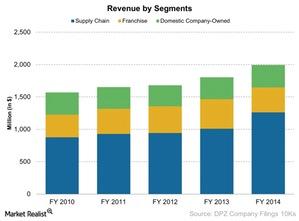Which of Domino’s Pizza’s Three Business Segments Performs Best?
Of its three main business segments, Domino’s Pizza earns least revenue from its company-owned stores.
March 26 2015, Updated 6:06 p.m. ET

Business segments
Domino’s Pizza (DPZ) business is broken down into three segments:
- supply chain
- company-owned restaurants
- franchised restaurants
Supply chain segment
Domino’s (DPZ) supply chain segment consists of facilities that manufacture fresh dough and other food items. It also involves the delivery of food items, as well as equipment and supplies, to franchised and company-owned stores. This segment accounts for 63% of Domino’s total supply chain sales in domestic and international markets.
The supply chain can be negatively impacted by higher commodity costs as well as changes in the menu mix.
Company-owned stores
Domino’s company-owned segment consists of restaurants in the US market. It accounts for 18% of Domino’s total sales. The company only has about 300 company-owned stores out of a system-wide total of 11,000. Domino’s uses these stores to test its products, promotional, or operational activities before rolling them out system wide. System-wide stores include company-owned as well as franchised restaurants.
McDonald’s (MCD) has over 35,000 restaurants in its system.
Competitor Papa John’s (PZZA) has 680 company-owned restaurants in the US. And Pizza Hut, under the umbrella of Yum! Brands (YUM), has 1,970 company-owned restaurants.
The Consumer Discretionary Select Sector SPDR Fund (XLY) has about 10% of its portfolio invested in restaurant stocks, including big chains that compete with the above-mentioned restaurants.
Franchised restaurants
Domino’s franchised segment consists of franchised restaurants in the US as well as in international markets. In fiscal 2014, revenue from the US franchise locations accounted for 12% of total sales, and international franchise revenue accounted for 7%.
